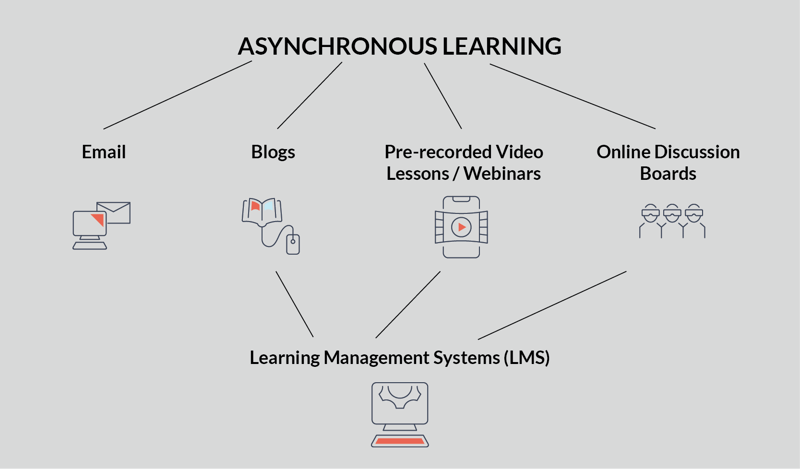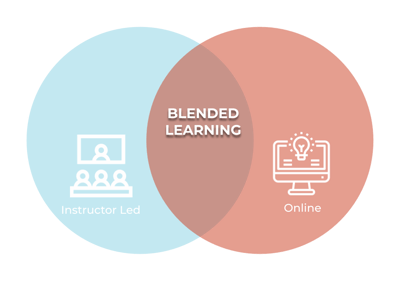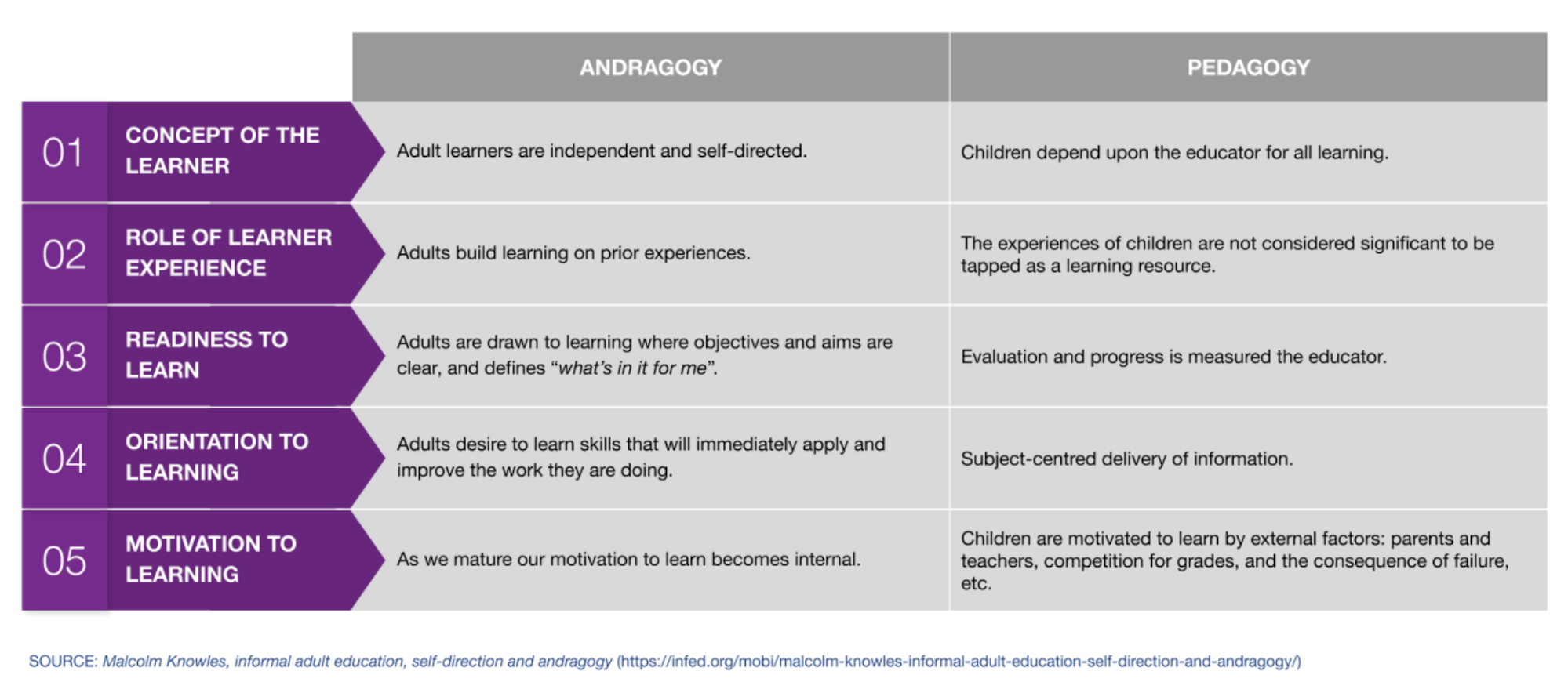2020 proved to be a sink or swim year for many associations and membership training. The forced shift to online alternatives from traditional, in-person, instructor-led training (ILT) has had mixed results. The digital move towards blended & asynchronous learning has provided an incredible opportunity for adult learning and professional development education.
Let’s face it: life under a pandemic is challenging. In a mere matter of months, COVID-19 has impacted nearly every aspect of our daily lives. It has changed the way many of us earn our living. It has altered how we enjoy quality time with our loved ones. It has even disrupted traditional holiday celebrations. The most controversial and disruptive of these changes has been the impact on international associations and their members. In the first terrifying weeks of the pandemic, the abrupt transition to online training was a matter of necessity; there was little, if any, preparation. COVID-19 has forced many organizations to teach and train remotely. Most of us were essentially just winging it, doing our best to preserve our ongoing training while protecting the lives of our members and our own. Unfortunately, the results haven’t been great. Many learners struggled, and critics were quick to blame the online format. But there’s ample evidence to show that the problem doesn’t rest with online learning or eLearning itself.
Remote Training vs. eLearning
The use of digital learning technologies outside the context of the traditional classroom are both utilized in remote or distance training and eLearning. However, that is as far as the commonality is between the two approaches. Many people seem to get the impression that the current experience with remote learning is comparable to what they would experience in a class specifically developed for a virtual setting. Simply moving traditional classroom content to an online space will not give you the same experience you would get in an online classroom that was specifically designed for the digital classroom.
Covid-19 caused many teaching and training organizations to quickly move their classroom-based content online and teach remotely. This phenomenon is referred to as reactive online training and learning; that is, the rapid modification and deployment of in-person, ILT courses into a virtual space to get the information to the intended audience as quickly as possible. Rather than creating lessons that are intended to be taught online, many organizations scrambled to adapt the in-person, face-to-face courses they have historically relied on, and modified them for a virtual, remote audience. Copying and pasting content to PowerPoint slides or converting them to PDF is not instructional design, the formalized, science-based method of course design that is used to develop online courses. Moreover, when we say a course is engaging does not mean just “clicks”. eLearning involves a curriculum that is specifically designed with a virtual audience in mind. The lessons and the technology used to conduct them are created and optimized to maximize the experience and provide quality interaction for the learner.
While the pandemic has left us all scrambling to go digital, there is a silver lining to the chaos it created: it has given us the opportunity to leverage technologies that offer more options and flexibility with training and other services to our association members. Online learning, when done right, can make training and learning more engaging, inclusive, and accessible than ever before. Not only for children but also for adult learners such as your association’s members.
Synchronous vs Asynchronous Learning
For adults, online learning is not only often highly effective; it can be an ideal, near-perfect solution for overcoming the obstacles that may have inhibited adults from learning in the past. After all, adults are busy. Many have jobs and families, seemingly endless responsibilities. And those obligations mean that very few can afford to sit in a brick-and-mortar classroom for several hours a week. Here is where online learning thrives and falls into three categories:
- Asynchronous (self-paced),
- Synchronous (in “real” time),
- or a “blend” of the two.
Synchronous learning works a lot like a traditional class meeting, with pre-scheduled or designated class times. The primary difference is that they are conducted generally through some kind of video-audio conferencing platform or online chat, and facilitated by an instructor. Learners attend a live online lecture at a particular time from an instructor. This method involves live interaction with the instructor.

An asynchronous or self-paced course means that course content and activities are preloaded on a learning platform, sometimes organized by topics, study units or modules. The learners themselves determine when and where they complete their work for that course. Asynchronous learning does not involve any live interaction with the instructor. And so, you might find yourself watching a class video on your tablet while you wait to pick your kid up from school. Or you might end up taking an online quiz during your lunch break. The kind of flexibility that usually only online courses can provide is exactly the kind of flexibility many adult learners need if they’re going to make it through.

Blended Learning Approach
Blended learning is a teaching or training approach that combines synchronous modes of engagement, such as ILT in a classroom or video conferencing, in combination with online asynchronous digital technology. These methods can include online courses and lectures, presentations, quizzes, games and more. It works collaboratively with a traditional classroom as training comes from both the instructor and online modules that work together.

As digital technologies advance, media-rich digital learning platforms can be personalized with adaptive courses and web conferencing tools that connect members with their trainers. This personalization moves us towards an impactful learning system that increases efficiency for your association and identifies members struggling with the course material.
Blended learning also motivates learners to use their critical thinking skills, promotes retention, increases learner engagement and strengthens their commitment to achieving their educational goals. These reasons are why a blended learning approach like online training for your association is the right choice for adult learners in their chosen fields.
Adult Learning
Adults do not learn the same way as children, and no learning theory suits each individual’s needs, despite the many models, assumptions, principles, and theories that have been put forth over the past hundred years. One thing that all these theories agree on is that the primary goal is to create an effective learning experience for adult learners in all industries and associations.
American educator Malcolm S. Knowles was the first to apply the term ‘andragogy’ to adult education and training, which is “the art and science of helping adults learn.” He also identified several factors that contrast between a child learner’s needs and that of an adult. These factors include self-concept, experience, readiness, orientation and motive. To make adult learning work for your members, you need to understand these concepts and put them into action.
Andragogy vs. Pedagogy: Knowles’ 5 Assumptions Characterizing Adult Learners

[Article] To go deeper on andragogy and adult learning, check out this article, The Andragogy Secret: How To Use Adult Learning Theory To Drive L&D Engagement Success
Making Adult Learning Theory Work For Your Association
To ensure your adult learning efforts achieve true understanding, engagement and comprehension, you should understand where adult learning theory struggles to apply to adult learning. First, let’s review Knowles’ five factors:
1. Self-Concept
When it comes to self-concept, unlike children, adults are independent and self-directed when it comes to their education. This is primarily because the relationship between learners and educators changes as we age. We become more independent and self-directed in our learning pursuits. This independence helps us work autonomously, allowing us to explore new topics on our own and process information very differently from children.
However, there are still issues when it comes to the concept of a learner. Malcolm Knowles identified a few problems when it comes to this. He found that many adult learners rebel when faced with situations that challenged their independence. He also discovered that due to many adults' prior education, they expect to be spoon-fed as they were when they were a child.
To prevent these issues, adult members of your association need to transition from passive to active learning. Your association needs to create an environment that fosters and supports self-directed learning skills. A support system needs to be put in place to serve as a framework, guide and reference. This will help members who are not independent learners to fill their knowledge gap while developing self-directed learning skills.
Once a support system is in place, your members need to take responsibility for their training. The best way to do this is to provide options for how a learner will engage with the training materials, whether it be text, videos or audio. You should also supply additional resources to help your members dive deeper into the topics.
2. Experience
When it comes to Knowles’ perception of experience in andragogy, adults learn by using their past experiences and building upon them. Learning becomes more intuitive as we rely on our past mistakes to act as guidelines for our educational pursuits.
To account for this prior experience, you need to take into account the diversity of your members. What can be helpful is conducting a preliminary survey to assess the gaps in knowledge and the varying skill levels of your audience. By preparing for these different skill sets and backgrounds, you can learn how to create an informative and engaging learning experience.
Peer learning becomes an asset as the collaboration between learners through various platforms like social media and other networking applications should be encouraged. Approaches that allow for the discussion of questions, group problem-solving, simulations and hands-on practice will strengthen the absorption of learning materials when done correctly. These approaches will aid in improving the behavioural engagement of your learners.
3. Readiness
Readiness implies the adult learner’s need for clearly defined objectives and goals catered to the individual’s requirements. Whether it is self-defined or projected onto the individual, an incentive can act as a great motivator that drives us to learn new skills. Knowing how the training will benefit the individual learner allows them to become more willing to learn when it is relevant and useful.
Context is vital when it comes to a learner’s readiness to learn. You need to engage members on an emotional, cognitive and behavioural level. By providing exercises and activities (like worksheets, checklists and tools) that tie back to your member’s lives and work, you will be giving them a reason to want to complete their lessons.
4. Orientation
Orientation is similar to readiness to learn, but the key difference is that readiness deals with the motivation to get started. In contrast, orientation focuses on engaging the adult learner as they learn. Trainers should emphasize how the learning topics will fix problems that are regularly encountered and offer real-life examples and scenarios (like case studies) to enable learners to apply the knowledge into the context of their lives.
As time is a valuable commodity among professionals, one type of time-saving strategy is microlearning. Microlearning can help make the most of your members’ time by creating small educational units that your members can learn in 5 to 10-minute segments. These micro-learning segments allow the adult learner flexibility and permit learning while on the go.
5. Motivation
Motivation becomes both external and internal as we mature, but internal pressures drive us to learn. These can take the form of desires, such as getting a new raise, improving self-esteem or expanding your members’ knowledge base. To ensure activities, modules, and assessments are retained, it is a good idea to explain to your learners why you are teaching these lessons. Putting things into perspective will improve engagement by making it relevant to the learner.
There are three opportunities to leverage motivation. The first is allowing your members to exercise their independence by choosing what, when and how they will learn. The second uses peer work and reflection to enable learners to create a deeper internal motive and learning experience. Lastly, members can collaborate and work within the association, creating a motivation to succeed and aid others through shared learning experiences.
Some Considerations about Online Learning
One of the most promising aspects of the future of online learning is its capacity to make education and training available to a diverse array of learners. This is particularly true for learners with chronic health conditions and disabilities who may not attend traditional courses.
Nevertheless, persons with disabilities may face unique challenges in online learning. For example, those with visual impairments, ranging from low visual acuity to significant colourblindness, may require special modifications to their technology to make the learning process all it can and should be.
The great news is that these modifications tend to be reasonably accessible and user-friendly. Indeed, many of these accessibility tools, from screen readers to Zoom capabilities to voice dictation to closed captioning, are often already built into the devices!
Engagement is the Key to Adult Learning
It is crucial to maximize an adult learner’s capabilities by creating an engaging environment that will cater to their needs. Learner engagement is “the willing and meaningful participation of an individual throughout the learning process that directly contributes to achieving the desired outcomes.”
Learner engagement involves three parts: emotional, behavioural, and cognitive, and it is both the responsibility of the trainer and the learner to achieve this delicate balance where all three aspects work together to create an impactful learning environment.
Emotional Engagement
The first part deals with emotional engagement. This engagement is between the adult learner and their training and can be assessed by determining their attitudes, interests and values toward their ongoing education. By completing an assessment of the learner’s emotional ties, trainers can determine the efficiency of their training modules, topics and delivery method.
To maximize their efficiency, your members should be well-informed about the necessity of the training they are undergoing and how it can impact their work. If done correctly, your members are more likely to engage with the content on an emotional level, thus improving emotional engagement.
Cognitive Engagement
Cognitive engagement occurs when there is a sustained intellectual effort to understand and master training content. Cognitive engagement indicators include the motivation and persistent effort to overcome learning challenges and meet or exceed the course’s requirements. Other indicators include critical thinking, setting goals, and developing plans to organize, monitor and improve their learning process.
If your members do not take an active role in pursuing their training or education, this fails to engage your learners cognitively. Ways to improve this is to foster the initiative by explaining the importance of learning and enhancing their prospects. You should help them discover new learning strategies to aid them in absorbing and retaining the information provided.
Behavioural Engagement
The last key factor in learner’s engagement is behavioural engagement, which entails the learner’s interaction and participation in the learning process. Indicators that your learners are engaging can be observed by how much time and effort is expended to master the content provided and the interactions with fellow peers concerning the learning experience. Their chosen tasks and social activities will provide the best means to determine whether your members are behaviourally engaged.
Reinforcement, application, and practice in the day-to-day routine will result from the development and implementation of training interventions. If your members lack in this area, they are not behaviourally engaged, and steps need to be taken to improve this issue.
Reflecting and asking questions about the content and the context in your member’s daily lives will help improve behavioural engagement. The result may be an overhaul of the content, treatment and relevance to the learner. As well as changes to the course design, development and implementation.
Power Professionals
But the future of online learning is about even more than providing adult learners with that all-important scheduling flexibility and on-demand, remote access. It’s also making it possible for busy working professionals, like your association’s members, to develop new skills and hone existing ones.
Best of all, remote learning can be easily customized to particular industries’ needs and the specific goals, values, and requirements of individual associations and their members.
For example, even the field of healthcare is highly amenable to distance education. Blended learning approaches, for instance, are being used with great success to help practicing and future clinicians develop critical skills using a combination of online content, simulations, and hands-on practice.
The Takeaway: The Future of Online Learning
Online learning may well be the future for associations as we adapt to a post-COVID-19 world. Whether you’re looking to complete certifications or compliance training, you can create impactful learning environments that meet your members’ needs. By applying a blended learning approach and considering Malcolm S. Knowles’s five andragogy factors, you are well on your way to make training for your association easy, engaging and efficient.
If you’re looking for more expert advice and how-to content on adult education, andragogy, and fostering learner engagement with your courses and training programs, here’s what our eLearning experts have put together for you:
- eBook: Attract Star Talent (And Keep Them!): Learning Paths for Employee Retention
- eBook: The All-Important E’s of eLearning: Engagement & Effectiveness
- eBook: Getting Engaged: How To Make Your Learners Fall in Love with Learning
- eBook: Using Analytics to Deliver Engaging Courses
- Webinar: How to Create Engaging and Effective eLearning
- Webinar: How To Use Interaction To Drive Engagement And Learning Outcomes
- Webinar: How to Reduce Disengagement with Gamification
- Webinar: Top 5 Practical Applications for Building Engaging Learning



